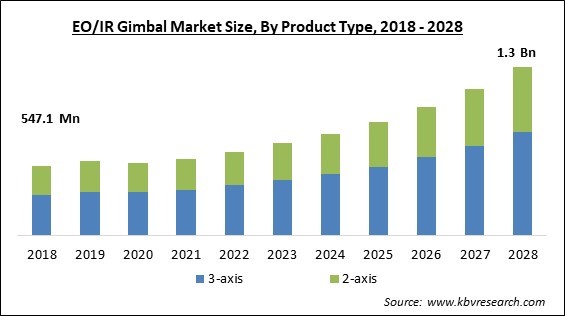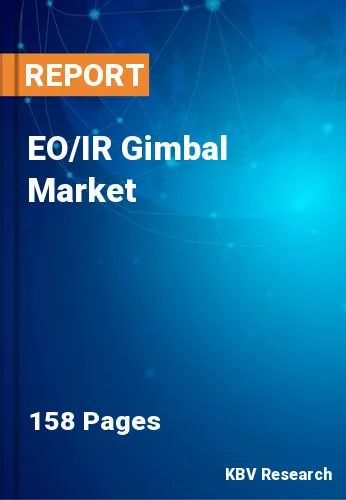The Global EO/IR Gimbal Market size is expected to reach $1.3 billion by 2028, rising at a market growth of 12.3% CAGR during the forecast period.
Gimbals are devices that stabilize the camera while filming video. The camera is mounted on one or more arms that absorb minor motions. Even if users make inadvertent movements, such as walking, the gimbal will maintain the camera stable. It works in the same way that a chicken's head remains stable when lifted and moved around. Gimbals are a digitally enhanced form of a small stabilizer. Gimbals are basically microscopic brains that can tell the difference between camera shake and deliberate movements. Gimbals have all of the sensing capabilities, as well as some pivots and quantities for a camera. Brushless motors enable the micro-adjustments of the arms, allowing the mounted camera to be absolutely steady.
A gimbal is a pivoted support that allows an item to rotate on a single axis. EO/IR gimbals are pivots containing electro-optical (EO) and infrared (IR) sensors, as well as a gyroscope to steady the camera attached to them. A compact gadget with a dual sensor, the electro-optics/infrared (EO/IR) gimbal, provides higher pointing precision. They have 360-degree continuous rotation and gyro-stabilization, which aid in reducing the tilt of an aircraft or boat. Search and rescue, aerial survey, fire inspection, and traffic surveillance are only some of the applications. The demand for sophisticated sensors and sighting devices, countermeasures, and reconnaissance is driving the growth of the EO/IR gimbals market.
Object tracking, navigation, onboard video encoding, real-time video stabilization, anti-vibration, and GEO-lock are all functions of EO/IR gimbals. The expansion of the EO/IR gimbals market is fueled by an increase in business interest in developing next-generation logistics, a spike in demand for drones for recreational purposes, and an increase in the demand for intelligent surveillance. Furthermore, several nations' limitations on the use of drones limit the growth of the EO/IR gimbal market. However, rising defense spending by various nations and increased R&D spending by market participants for product development are factors that would boost the EO/IR gimbal market outlook throughout the forecast period.

The coronavirus outbreak caused a halt in manufacturing in 2020 due to the worldwide lockdown scenario causing an interruption in the total supply chain of electronic components. As the core of the virus pandemic, Wuhan, China, accounts for the greatest manufacturing products of electronic components, the COVID-19 outbreak has caused a delay in satisfying end-user needs. The global spread of this disease was declared a Public Health Emergency of International Concern on January 30, 2020. The US government blacklisted DJI Company, along with dozens of other Chinese companies, in December 2020, causing component and technology prices to rise. Due to global travel limitations, this interruption in the demand-supply chain is projected to cause market share to drop sharply.
An integrated electro-optical sensor and an infrared sensor make up the EO/IR system. These two sensors work together to detect targets at many wavelengths, including ultraviolet, near-infrared, short-wavelength infrared, medium-wavelength infrared, and long-wavelength infrared. Depending on the design of the EO/IR system, the given information can be in picture or signal format. Non-imaging Eo/IR systems, such as infrared search and track systems, are primarily focused on target point detection (IRST). Furthermore, the imaging system provides a detailed view of the target at various wavelengths and in various weather conditions. This information aids in obtaining more precise target specifics both during the day and at night.
Unmanned vehicles for land, sea, and air platforms are being developed as manufacturing technologies advance. Unmanned vehicles are increasingly being used for a variety of military and commercial applications, including surveillance, navigation, policing, photography, product deliveries, and agricultural monitoring. With the improvement in remote operations, the defense sector is seeing strong adoption of unmanned vehicles for military applications. Current autonomous vehicles have sensors and cameras embedded within them that offer many wavelength information for accurate detection and monitoring.
The widespread development and use of drones, as well as unintended accidents, have necessitated the development of counter UAV technology or anti-drone devices to neutralize rogue drones. C-UAS, counter-UAS, or C-UAS technology refers to a sort of gadget used to find, fix, identify, track, and neutralize unidentified unmanned aerial aircraft (UAVs). Hundreds of counter-UAS are being developed around the world as a result of many investments in this lucrative business. The United States, the United Kingdom, Australia, and Germany, among others, are investing in anti-UAS programs.

Based on Product Type, the market is segmented into 3-axis and 2-axis. The 2-axis segment procured a significant revenue share in the EO/IR gimbal market in 2021. A two-axis gimbal helps to stabilize the camera just on the pitch and roll axes. When it comes to taking still photos, 2-axis gimbals can compete with 3-axis counterparts. These gimbals are more cost-effective.
Based on End Use, the market is segmented into Defense, UAV/UAS, Law Enforcement, Marine, and Others. The defense segment acquired the largest revenue share in the EO/IR gimbal market in 2021. This is due to many developed and developing countries across the globe investing heavily in their military to enhance and update it to the latest technologies. EO/IR gimbals are used in the defense sector. These are usually deployed on drones to make the attached camera work optimally. The use of drones instead of manned aircraft helps the military protect its men.
| Report Attribute | Details |
|---|---|
| Market size value in 2021 | USD 608.2 Million |
| Market size forecast in 2028 | USD 1.3 Billion |
| Base Year | 2021 |
| Historical Period | 2018 to 2020 |
| Forecast Period | 2022 to 2028 |
| Revenue Growth Rate | CAGR of 12.3% from 2022 to 2028 |
| Number of Pages | 163 |
| Number of Tables | 270 |
| Report coverage | Market Trends, Revenue Estimation and Forecast, Segmentation Analysis, Regional and Country Breakdown, Companies Strategic Developments, Company Profiling |
| Segments covered | Product Type, End Use, Region |
| Country scope | US, Canada, Mexico, Germany, UK, France, Russia, Spain, Italy, China, Japan, India, South Korea, Singapore, Malaysia, Brazil, Argentina, UAE, Saudi Arabia, South Africa, Nigeria |
| Growth Drivers |
|
| Restraints |
|
Based on Regions, the market is segmented into North America, Europe, Asia Pacific, and Latin America, Middle East & Africa. North America acquired the highest revenue share in the EO/IR gimbal market in 2021. This is due to an increase in government and defence agency investments. The United States has the highest defence expenditure in the world, and this has enabled it to modernize its military and adopt the latest technologies. The demand for EO/IR gimbals for use in drones is estimated to stay high in the region in the upcoming years.
Free Valuable Insights: Global EO/IR Gimbal Market size to reach USD 1.3 Billion by 2028
The market research report covers the analysis of key stake holders of the market. Key companies profiled in the report include AeroVironment, Inc., L3Harris Technologies, Inc.(L3Harris WESCAM), Teledyne FLIR LLC (Teledyne Technologies Incorporated), Lockheed Martin Corporation, Ascent Vision Technologies LLC (CACI International Inc.), Leonardo DRS, Inc. (Leonardo SpA), Guilin Zhishen Information Technology Co., Ltd., Merio - UAV Payload Systems, Innovative Injection Technologies, Inc., and Harris Aerial LLC.
By Product Type
By End Use
By Geography
The EO/IR gimbal market size is projected to reach USD 1.3 billion by 2028.
Providing detailed information are increasing are driving the market in coming years, however, rise of anti-drone systems growth of the market.
AeroVironment, Inc., L3Harris Technologies, Inc.(L3Harris WESCAM), Teledyne FLIR LLC (Teledyne Technologies Incorporated), Lockheed Martin Corporation, Ascent Vision Technologies LLC (CACI International Inc.), Leonardo DRS, Inc. (Leonardo SpA), Guilin Zhishen Information Technology Co., Ltd., Merio - UAV Payload Systems, Innovative Injection Technologies, Inc., and Harris Aerial LLC.
Yes, COVID-19 outbreak has caused a delay in satisfying end-user needs. due to global travel limitations, this interruption in the demand-supply chain is projected to cause market share to drop sharply.
The 3-axis market dominated the Global EO/IR Gimbal Market by Product Type in 2021, thereby, achieving a market value of $814.6 Million by 2028.
The North America market dominated the Global EO/IR Gimbal Market by Region in 2021, and would continue to be a dominant market till 2028.
Our team of dedicated experts can provide you with attractive expansion opportunities for your business.

